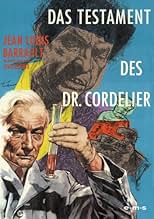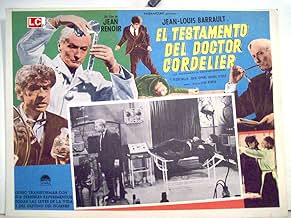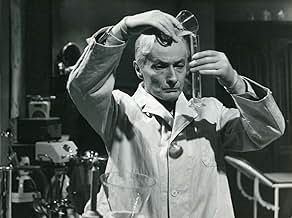O Testamento do Dr Cordelier
Título original: Le testament du Docteur Cordelier
AVALIAÇÃO DA IMDb
6,5/10
1,3 mil
SUA AVALIAÇÃO
Adicionar um enredo no seu idiomaMr. Joly, doctor Cordelier's lawyer, is amazed to discover that his client and friend leaves his possessions to a stranger, Opale, a sadistic criminal. He needs this man to prove that people... Ler tudoMr. Joly, doctor Cordelier's lawyer, is amazed to discover that his client and friend leaves his possessions to a stranger, Opale, a sadistic criminal. He needs this man to prove that people's behavior can be adjusted at will...Mr. Joly, doctor Cordelier's lawyer, is amazed to discover that his client and friend leaves his possessions to a stranger, Opale, a sadistic criminal. He needs this man to prove that people's behavior can be adjusted at will...
- Direção
- Roteiristas
- Elenco e equipe completos
- Produção, bilheteria e muito mais no IMDbPro
Enredo
Você sabia?
- CuriosidadesThis TV program later had a theatrical release.
Avaliação em destaque
Frankly, I have lost count of how many cinematic adaptations of Robert Louis Stevenson's classic story, "Dr. Jekyll and Mr. Hyde", I have watched but, since Jean Renoir is one of my favorite film-makers, this rarely-seen film had always been one of my holy grails. Before now, it had been available only as an unsubtitled French DVD - which I had even considered buying at one point but now I am sure glad I waited!
Curiously enough for such a master of the film medium, Renoir's version was shot for TV - it even starts off with the bubbly writer/director entering the studio to 'present' the show - although it did get eventually released to French theaters in late 1961. Having said that, it is quite appropriate given the subject matter that Renoir himself seemed to be in an experimental state of mind: shooting with three to eight cameras and cutting only at the end of each sequence, his intention was to free his actors from the filmic constraints of relentless cutting and repeated takes.
No one benefited more from this deliberately 'flat' approach to the material than his inspired choice for lead actor, Jean Louis Barrault, the celebrated mime best-known for his role in Marcel Carne''s CHILDREN OF PARADISE (1945): his is a truly remarkable performance. We see Cordelier (the Jekyll figure) during three stages of his life: the time when, as a young general practitioner, he first hit upon the notion that good and evil could be separated; the distinguished research scientist, gracefully aged but something of a recluse and, of course, Opale - wearing no make-up except for a set of false teeth and a shaggy wig, Renoir and Barrault's bizarre concept of Hyde as a prancing ("light as air" as he himself puts it) thug with overgrown hair whose mayhem perhaps feels more like the thrill-seeking antics of a spoiled brat (at times recalling Renoir's earlier creation, Boudu, as a matter of fact) rather than the handiwork of someone who is supposedly evil incarnate...although, he does kick the living hell out of his victims as they lie helplessly on the ground!
Two other notable secondary characters are the lawyer (Teddy Bilis) who is baffled by Cordelier's singular will but who sticks by his friend till the bitter end, and Michel Vitold's irascible psychiatrist, a rival of Cordelier's and whose heart condition Opale sadistically exploits; interestingly, Vitold would later play the villainous banker Favraux in Georges Franju's marvelous remake of JUDEX (1963). Renoir regular Gaston Modot is also featured as Barrault's elderly handyman: he had been the lead in Luis Bunuel's L'AGE D'OR (1930) and the scene here in which Opale kicks a crutch from under a limping man recalls the one in the notorious Surrealist film where Modot's anarchic protagonist pushes a blind man into a busy street. Another veteran of Renoir's cinema is composer Joseph Kosma whose wonderful score emerges as another major asset. The fact that its plot essentially centers around the mysterious goings-on in the household of an eminent physician reminded me of the contemporaneous EYES WITHOUT A FACE (1959) even if, as I said earlier, there is little room here for poetic images so prevalent in Franju's film. Incidentally, just as I never refer to that film by its silly American moniker - THE HORROR CHAMBER OF DR. FAUSTUS - I loathe Lionsgate's decision to attach the unflattering title THE DOCTOR'S HORRIBLE EXPERIMENT to the Renoir picture!
Despite the action being relocated to Paris and set in contemporary times, this is actually one of the most faithful renditions of Stevenson's work: it is virtually the only film version which lends its central theme of good vs. evil a spiritual resonance (the doctor even commits suicide, while still in his Opale persona, by taking a lethal dose of his own potion) where most other adaptations had just opted to concentrate on the element of repressed sexuality inherent in Stevenson's original. In fact, there is no significant female character here at all. Renoir does give us hints in that direction, however, as we do see Cordelier (rather than Opale) corrupted - time and again, we are told on his tape-recorded confession - into ravishing his patients while they are under the anaesthetic. The metamorphosis is clearly a painful one and Cordelier assumes a foetal position during the first transformation indicating a physical rebirth; interestingly, given that the film is not structured in a linear fashion, we meet Opale, roaming the streets of Paris at night, before we are formally introduced to his benign alter-ego, Dr. Cordelier.
In conclusion, THE TESTAMENT OF DR. CORDELIER not only emerges as easily one of the best filmed versions of the novel - edged only by the Rouben Mamoulian/Fredric March 1931 milestone and just ahead of Walerian Borowczyk's delirious DOCTEUR JEKYLL ET LES FEMMES (1981), which it predates in several aspects - but as yet another great Renoir work. Hardly the "risible...probably the only disaster in the Renoir canon" dismissal one reads about in David Quinlan's book on film directors! On a more personal note, I am disappointed by the sheer lack of online reviews of this important 3-Disc Set from Lionsgate and, hopefully, I will not only get to the rest of the Renoir films therein in due time but may also take this opportunity to watch Giorgio Albertazzi's similarly modernized 4-hour adaptation made for Italian TV, JEKYLL (1969), which I recently acquired.
Curiously enough for such a master of the film medium, Renoir's version was shot for TV - it even starts off with the bubbly writer/director entering the studio to 'present' the show - although it did get eventually released to French theaters in late 1961. Having said that, it is quite appropriate given the subject matter that Renoir himself seemed to be in an experimental state of mind: shooting with three to eight cameras and cutting only at the end of each sequence, his intention was to free his actors from the filmic constraints of relentless cutting and repeated takes.
No one benefited more from this deliberately 'flat' approach to the material than his inspired choice for lead actor, Jean Louis Barrault, the celebrated mime best-known for his role in Marcel Carne''s CHILDREN OF PARADISE (1945): his is a truly remarkable performance. We see Cordelier (the Jekyll figure) during three stages of his life: the time when, as a young general practitioner, he first hit upon the notion that good and evil could be separated; the distinguished research scientist, gracefully aged but something of a recluse and, of course, Opale - wearing no make-up except for a set of false teeth and a shaggy wig, Renoir and Barrault's bizarre concept of Hyde as a prancing ("light as air" as he himself puts it) thug with overgrown hair whose mayhem perhaps feels more like the thrill-seeking antics of a spoiled brat (at times recalling Renoir's earlier creation, Boudu, as a matter of fact) rather than the handiwork of someone who is supposedly evil incarnate...although, he does kick the living hell out of his victims as they lie helplessly on the ground!
Two other notable secondary characters are the lawyer (Teddy Bilis) who is baffled by Cordelier's singular will but who sticks by his friend till the bitter end, and Michel Vitold's irascible psychiatrist, a rival of Cordelier's and whose heart condition Opale sadistically exploits; interestingly, Vitold would later play the villainous banker Favraux in Georges Franju's marvelous remake of JUDEX (1963). Renoir regular Gaston Modot is also featured as Barrault's elderly handyman: he had been the lead in Luis Bunuel's L'AGE D'OR (1930) and the scene here in which Opale kicks a crutch from under a limping man recalls the one in the notorious Surrealist film where Modot's anarchic protagonist pushes a blind man into a busy street. Another veteran of Renoir's cinema is composer Joseph Kosma whose wonderful score emerges as another major asset. The fact that its plot essentially centers around the mysterious goings-on in the household of an eminent physician reminded me of the contemporaneous EYES WITHOUT A FACE (1959) even if, as I said earlier, there is little room here for poetic images so prevalent in Franju's film. Incidentally, just as I never refer to that film by its silly American moniker - THE HORROR CHAMBER OF DR. FAUSTUS - I loathe Lionsgate's decision to attach the unflattering title THE DOCTOR'S HORRIBLE EXPERIMENT to the Renoir picture!
Despite the action being relocated to Paris and set in contemporary times, this is actually one of the most faithful renditions of Stevenson's work: it is virtually the only film version which lends its central theme of good vs. evil a spiritual resonance (the doctor even commits suicide, while still in his Opale persona, by taking a lethal dose of his own potion) where most other adaptations had just opted to concentrate on the element of repressed sexuality inherent in Stevenson's original. In fact, there is no significant female character here at all. Renoir does give us hints in that direction, however, as we do see Cordelier (rather than Opale) corrupted - time and again, we are told on his tape-recorded confession - into ravishing his patients while they are under the anaesthetic. The metamorphosis is clearly a painful one and Cordelier assumes a foetal position during the first transformation indicating a physical rebirth; interestingly, given that the film is not structured in a linear fashion, we meet Opale, roaming the streets of Paris at night, before we are formally introduced to his benign alter-ego, Dr. Cordelier.
In conclusion, THE TESTAMENT OF DR. CORDELIER not only emerges as easily one of the best filmed versions of the novel - edged only by the Rouben Mamoulian/Fredric March 1931 milestone and just ahead of Walerian Borowczyk's delirious DOCTEUR JEKYLL ET LES FEMMES (1981), which it predates in several aspects - but as yet another great Renoir work. Hardly the "risible...probably the only disaster in the Renoir canon" dismissal one reads about in David Quinlan's book on film directors! On a more personal note, I am disappointed by the sheer lack of online reviews of this important 3-Disc Set from Lionsgate and, hopefully, I will not only get to the rest of the Renoir films therein in due time but may also take this opportunity to watch Giorgio Albertazzi's similarly modernized 4-hour adaptation made for Italian TV, JEKYLL (1969), which I recently acquired.
- Bunuel1976
- 8 de mai. de 2007
- Link permanente
Principais escolhas
Faça login para avaliar e ver a lista de recomendações personalizadas
Detalhes
Bilheteria
- Orçamento
- FRF 60.000.000 (estimativa)
- Tempo de duração1 hora 35 minutos
- Cor
- Mixagem de som
- Proporção
- 1.33 : 1
Contribua para esta página
Sugerir uma alteração ou adicionar conteúdo ausente

Principal brecha
By what name was O Testamento do Dr Cordelier (1959) officially released in Canada in English?
Responda





















